Lake District
Explore hidden histories, historic photos, and things you never knew about Lake District from the collections and archives of Historic England.
Discover your local listed buildings and places
Introducing some of Lake District's most historic sites, included in the National Heritage List for England. Some of these captions have been summarised by AI. Click through for the official List entry. Skip this section and go to place by numbers
The English Lake District
Above Derwent
The English Lake District is recognised as a landscape of extraordinary harmonious beauty and inspiration, its natural features enhanced with man-made activity - traditional hill farming,...
Coombe Gill Mill
Borrowdale
Water-powered cornmill, early C18 with possible earlier origins, and an attached corn drying kiln and store, probably C18.
The Howk Bobbin Mill
Caldbeck
An L-shaped, two-storey mill house with associated buildings and features including a coppice barn, a drying kiln, a privy, offices/stable, retaining walls, tracks and part of the water...
Castlerigg stone circle and two bowl barrows
St. John's Castlerigg and Wythburn
Castlerigg is one of England's finest large irregular stone circles, reflecting prehistoric ritual significance, rare examples of social gatherings, and calendar function from Late Neolithic...
Mireside Farmhouse and bank barn
Crosthwaite and Lyth
Farmhouse, late C17 with C18 alterations, and bank barn of later C18 or early-C19 date.
Goldscope copper and lead mines and remains of associated…
Above Derwent
Goldscope mines in Cumbria are significant for their medieval origins and post-medieval mining influenced by German technology through the Mines Royal Company.
Carrock Fell tungsten, lead, copper, and arsenic mines an…
Mungrisdale
Carrock Fell mine in Cumbria reflects an important phase in tungsten, lead, copper, and arsenic mining, with significant 20th-century surface features highlighting mining history.
Collinfield Farmhouse and two bank barns
Cartmel Fell
Farmhouse, C17 with C18 addition and two bank barns of late C18 or early-C19 date.
Prehistoric hut circle settlements, enclosure, cairnfield…
Blawith and Subberthwaite
The prehistoric landscape on Heathwaite Fell showcases extensive Bronze Age and medieval activity, with well-preserved settlements, field systems, cairnfields, and kilns enhancing our...
Two rifle ranges on Silver How
Lakes
The remains of two mid-C19 military rifle ranges (300 yards and 800 yards) oriented north-west to south-east, situated above Grasmere on the lower slopes of Silver How adjacent to the public...
Sizergh Castle
Helsington
Sizergh Castle, a former pele tower dating back to the 14th century, features historical gardens developed by T Hayes & Son in 1926. Owned by the National Trust since 1950.
Lowwood gunpowder works
Haverthwaite
Lowwood gunpowder works is key for its representation of 19th-century manufacturing technology.
The Langdale Boulders, two prehistoric rock art sites in …
Lakes
The Langdale Boulders, located in Great Langdale, are notable prehistoric rock art sites.
Lowther Castle
Askham
Lowther Castle, designed by Robert Smirke in the early 19th century, was the seat of the Lowther family since the 12th century, now maintained as a controlled ruin.
The Cockpit stone circle and seven adjacent clearance cai…
Barton and Pooley Bridge
The Cockpit is a significant prehistoric stone circle on Moor Divock, with adjacent clearance cairns, illustrating its historical and ritual importance in prehistoric Cumbria.
Beckside farmhouse and barns
Crook
Farmhouse, later C17 with mid-late C19 addition; bank barn and threshing barn, late C18 or early C19.
Storrs Hall
Windermere
Simple classical villa, mid 1790s, for Sir John Legard, transformed c1808-9 by Joseph Gandy for John Bolton. The clerk of works was Francis Webster.
Rydal Mount
Lakes
Rydal Mount, designed by poet William Wordsworth, blends Picturesque ideals with historical continuity. Featuring terraced gardens and scenic views, it reflects 19th-century artistic tastes.
Rydal Hall
Lakes
Sir Daniel Fleming built a grotto in 1669 for viewing a waterfall, enhancing Rydal Hall's aesthetics. The Hall's gardens, designed by Thomas Mawson, date back to circa 1909.
Ambleside Roman fort, associated vicus and Roman road
Lakes
Ambleside Roman fort and its vicus are significant for their rare insights into Roman military strategy.
Sunkenkirk Stone Circle, 230m south east of Swinside
Millom Without
Sunkenkirk Stone Circle is a rare prehistoric monument exemplifying Neolithic/Bronze Age ritual practices.
Eastward Farmhouse and attached Barns
Bampton
Farmhouse, probably late C17, extended in the C18, with minor C20 adaptations; two attached combination barns, probably C18 or early C19, with later additions.
Moated site of Loweswater Pele
Buttermere
Loweswater Pele, a medieval moated manor, features a natural hillock modified with ditches, linked to Ranulphe de Lindesaye in the 12th century.
Belle Isle
Windermere and Bowness
Belle Isle on Lake Windermere features a Grade I listed cylindrical mansion designed by John Plaw in 1774, noted for its picturesque setting and historical tourism significance.
Ravenglass Roman fort bath-house, also known as Walls Castle
Muncaster
The Ravenglass Roman fort bath-house, known as Walls Castle, is the best preserved Roman military bath-house, showcasing distinctive architectural features like niches, arches, and rendered...
Keswick War Memorial
Keswick
First World War memorial, 1922, with later additions for the Second World War.
Blackwell
Windermere and Bowness
Blackwell, designed by Baillie Scott in Vernacular Revival style, features Mawson's formal gardens showcasing scenic views of Lake Windermere, historical significance, and arts and crafts...
Muncaster Castle
Muncaster
Muncaster Castle, renovated by Anthony Salvin in the 19th century for Lord Muncaster, features an impressive interior, including a panelled hall and octagonal library.
Greenside lead mines, ore works and smelt mill
Patterdale
Greenside lead mine exemplifies significant technological advancements in lead mining over 300 years, featuring diverse historical mining structures and innovative uses of technology for...
Undermount
Lakes
A vernacular house of one and two storeys of early C19 date with earlier origins, architect unknown.
Mosedale Quaker Meeting House and adjoining stables
Mungrisdale
Quaker meeting house and adjoining stables, C18, with C19 and C20 alterations.
Muncaster Castle
Muncaster
Muncaster Castle's gardens originate from the 18th century and feature pleasure grounds with rhododendron collections and parkland dating back to the 16th century.
Cairnfield including a prehistoric enclosure, 5 stone cir…
Eskdale
The cairnfield on Burnmoor features prehistoric enclosures, stone circles, cairns, and stone banks, providing insights into Bronze Age agricultural and social practices.
Two Roman forts and three sections of Roman road at Caermote
Bewaldeth and Snittlegarth
The Roman forts at Caermote, built predominantly between the first and second centuries AD, were vital for military strategy, controlling access and potentially lead production.
Troutbeck Roman fort and annexe
Hutton
Troutbeck Roman fort, dating to the late 1st or early 2nd century AD, played a key role in policing and controlling access into the Lake District.
Brockhole
Lakes
Brockhole features gardens designed by Thomas Mawson and a house by Dan Gibson, blending park and woodland along Lake Windermere, contributing to its historic significance.
Gardens at Graythwaite Hall
Satterthwaite
Garden around Graythwaite Hall, designed by Thomas Mawson between 1889 and 1895, for Thomas Myles Sandys MP.
Explore more
Search for more listed placesLake District through time
This timeline shows the first period of use for buildings and places on the National Heritage List for England, just one of the details recorded for every list entry. Click around to see how Lake District changes over time. Skip this section and go to aerial photos
Prehistoric Before AD 43
Prehistory covers a million years of human occupation before the Roman invasion, from hunter-gatherers of several human species, including Neanderthals, to more recent herders and farmers. It was a time of developing technologies and belief systems, involving contact with and migration from Europe, all reflected in the variety of artefact and monument types characteristic of particular prehistoric periods.
Roman AD 43 to AD 410
Britain was invaded by four legions of the Roman army in AD 43, who relatively rapidly conquered England from landing points in Kent. Parts of Wales and Scotland soon followed.
Roman culture brought urbanism, monumental buildings, wide-ranging religious beliefs, writing, and strong social hierarchy. The Roman administrative system was withdrawn in AD 410.
Early medieval AD 410 to AD 1066
This period, often associated in England with Anglo-Saxons and Vikings, saw a reduction in urban living from the Roman period and increased migration from northern Europe.
Traces of this period can be found in cemeteries, particularly in artefacts and in some of the very early churches, as this period also saw the growth of Christianity in Britain.
Medieval AD 1066 to AD 1540
This period, sometimes known as the Middle Ages, began with the Norman invasion in AD 1066. It saw a significant rise in military and defensive buildings such as castles and earthworks, as well as religious houses dominating a largely agricultural landscape.
The monarchy and Church dominated the period, which also saw the break with the Roman Catholic Church and the English reformation.
Post medieval AD 1540 to AD 1901
The Post-Medieval period brought seismic changes to life in England, with religious reformation leading to the democratization of worship and the destruction of hundreds of religious houses.
In parallel, there was a huge expansion of scientific study and enlightenment that permanently altered the nation's social structure and landscape. Industrialization and mass production lead to wider global trade, emigration, and immigration.
20th century AD 1901 to AD 2000
The 20th century saw an incredible expansion of England's transport networks, with suburban growth shadowing rapid infrastructural expansion. The establishment of state schools, hospitals, and modern technical colleges, with new architectural styles, radically changed the appearance of towns and cities.
Two catastrophic world wars and the 1918 pandemic also brought unprecedented change, altering England's built environment and social structures forever.
Prehistoric Before AD 43
Prehistory covers a million years of human occupation before the Roman invasion, from hunter-gatherers of several human species, including Neanderthals, to more recent herders and farmers. It was a time of developing technologies and belief systems, involving contact with and migration from Europe, all reflected in the variety of artefact and monument types characteristic of particular prehistoric periods.
Roman AD 43 to AD 410
Britain was invaded by four legions of the Roman army in AD 43, who relatively rapidly conquered England from landing points in Kent. Parts of Wales and Scotland soon followed.
Roman culture brought urbanism, monumental buildings, wide-ranging religious beliefs, writing, and strong social hierarchy. The Roman administrative system was withdrawn in AD 410.
Early medieval AD 410 to AD 1066
This period, often associated in England with Anglo-Saxons and Vikings, saw a reduction in urban living from the Roman period and increased migration from northern Europe.
Traces of this period can be found in cemeteries, particularly in artefacts and in some of the very early churches, as this period also saw the growth of Christianity in Britain.
Medieval AD 1066 to AD 1540
This period, sometimes known as the Middle Ages, began with the Norman invasion in AD 1066. It saw a significant rise in military and defensive buildings such as castles and earthworks, as well as religious houses dominating a largely agricultural landscape.
The monarchy and Church dominated the period, which also saw the break with the Roman Catholic Church and the English reformation.
Post medieval AD 1540 to AD 1901
The Post-Medieval period brought seismic changes to life in England, with religious reformation leading to the democratization of worship and the destruction of hundreds of religious houses.
In parallel, there was a huge expansion of scientific study and enlightenment that permanently altered the nation's social structure and landscape. Industrialization and mass production lead to wider global trade, emigration, and immigration.
20th century AD 1901 to AD 2000
The 20th century saw an incredible expansion of England's transport networks, with suburban growth shadowing rapid infrastructural expansion. The establishment of state schools, hospitals, and modern technical colleges, with new architectural styles, radically changed the appearance of towns and cities.
Two catastrophic world wars and the 1918 pandemic also brought unprecedented change, altering England's built environment and social structures forever.
Aerial photos of Lake District
Aerial photography helps reveal secrets of England's changing landscapes that are impossible to see from the ground. Skip this section and go to archive images
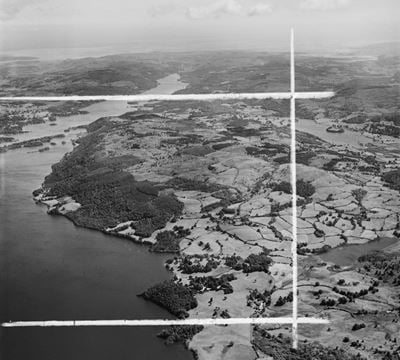
High Wray
Countryside between Windermere and Esthwaite Water, High Wray, 1952

Low Wray
Wray Castle alongside Windermere, Low Wray, 1953
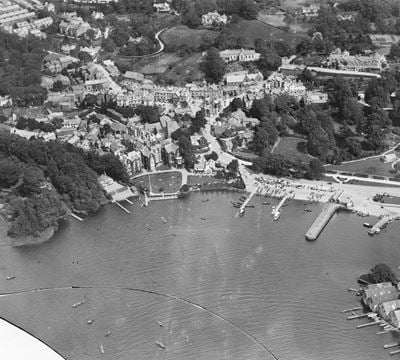
Bowness On Windermere
Bowness Bay, Bowness on Windermere, 1920
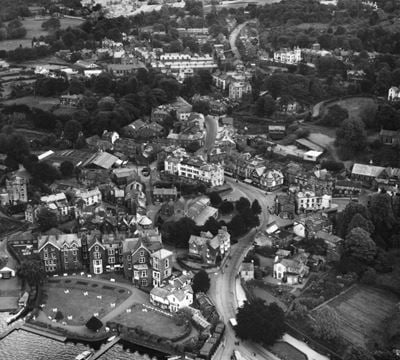
Bowness-On-Windermere
The town, Bowness-On-Windermere, 1949

Lakeside
The Swan Hotel, Lakeside, 1951

Lakeside
Newby Bridge and the Swan Hotel, Lakeside, 1951
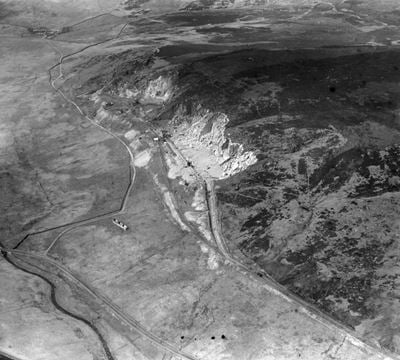
Shap Fells
Shap Granite Quarries, Shap Fells, 1929
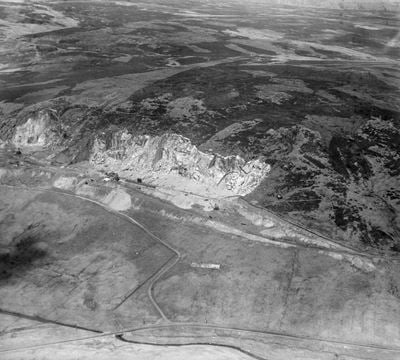
Shap Fells
Shap Granite Quarries, Shap Fells, 1929

Bowness-On-Windermere
The Burnside Hotel, Bowness-On-Windermere, 1949
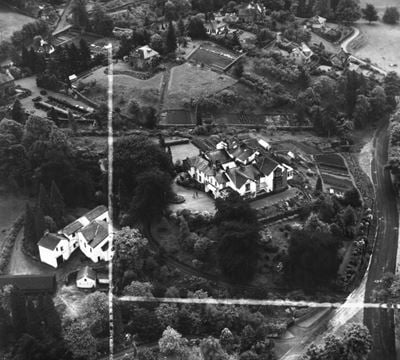
Bowness-On-Windermere
The Burnside Hotel, Bowness-On-Windermere, 1949
Lake District in the Historic England Archive
The Historic England Archive cares for over 15 million images, dating from the 1850s to the present day. Discover stunning images of Lake District's past. Skip this section and go to stories about heritage
Charles George Harper Collection
Copeland, Cumbria
Date created: 1892 - 1933
Muncaster Castle, seen from the south-west
Eric de Mare
Ambleside, South Lakeland, Cumbria
Date created: 1945 - 1980
General view of stepping stones in Ambleside.
John Gay Collection: Rural Life
South Lakeland, Cumbria
Date created: 22 DEC 1953 - 07 JAN 1954
An interior view of a stone barn at Middle Fell Farm, showing a farmer carrying buckets through the doorway and a cow waiting to be milked.
John Gay Collection: Miscellaneous
Allerdale, Cumbria
Date created: 1958
Detail view of the interior of a dwelling in the Borrowdale Parish of Cumbria, possibly in or near Rosthwaite, showing a dog curled up on the seat of...
John Gay Collection: Counties
South Lakeland, Cumbria
Date created: 22 DEC 1953 - 07 JAN 1954
Middlefell Place Farmhouse in Great Langdale with the stone shippons to house the animals continuing under the same roof
John Laing Collection
Bowness On Windermere, South Lakeland, Cumbria
Date created: 15 Oct 1975
View of the boating complex at Lake Windermere
London, Midland and Scottish Railway Company
South Lakeland, Cumbria
Date created: 1886
A man launching a rowing boat from a small jetty at the edge of Coniston Lake
Nigel Temple Collection of Postcards of Parks and Gardens
Derwentwater, Allerdale, Cumbria
Date created: 1920 - 1935
GENERAL VIEW WITH DERWENTWATER IN BACKGROUND
Charles George Harper Collection
South Lakeland, Cumbria
Date created: 1892 - 1933
Exterior view of Coniston Hall
London, Midland and Scottish Railway Company
Copeland, Cumbria
Date created: 30 Apr 1886
A view of Trough House Bridge over the River Esk
Stories about heritage in your local area
Historic England publishes news, blogs, research, videos, and podcasts celebrating England's rich heritage. Discover the stories we have about Lake District. Skip this section and go to education
Narrative Structures: England’s Literary History in 11 Places
Mentions Dove Cottage at Town End
Discover the historic sites in England where famous writers found their inspiration.
5 Facts About the Vikings in England
Mentions High cross in St Mary's churchyard
A quick introduction to the Viking Age in England.
Traces of the Vikings in England
Mentions High cross in St Mary's churchyard
Explore the archaeological traces and standing remains that tell us about Viking life and and culture in England.
An Introduction to Quaker Meeting Houses
Mentions Mosedale Quaker Meeting House and adjoining stables
The earliest Quaker meeting houses were distinctive for their simple, functional design; built by local craftsmen, they sit modestly in the landscape.
13 Roman Ruins to Visit in England
Remains of Roman Britain can be found everywhere, from walls left in our cities to forts and villas in the countryside.
William Wordsworth and the History of the Daffodil
Mentions Dove Cottage at Town End
In honour of William Wordworth, we contemplate daffodils and their place in our culture.
7 Things You May Not Know About Listing
Mentions High Street, Roman road
The List (of England's heritage assets) is full of wonderful examples of our creativity, innovation and humour.
Thou Shalt Not Kill: 7 Sites of Memory to Conscientious Objectors
Mentions Conscientious Objectors’ Stone, 140m south east of Green Moor farmhouse
It is believed that as many as 20,000 men from all walks of life were originally on record as conscientious objectors between 1916 and 1918, refusing...
7 Spooky Tales from England’s Haunted Castles
Mentions Muncaster Castle
Spooky tales are knitted into English folklore and make their mark on our historical places.
A Brief Introduction to England’s Secret Printing Presses
Mentions Outbuilding Approximately 30 Metres to South of Brantwood
Curious about arts and crafts, mystified by medieval settlements or intrigued by industrial heritage? Our new “Brief Introduction to” series provides...
7 Inspiring Writers’ Retreats
Mentions Hill Top
Many of our favourite author’s writing spots are protected.
Mentions Lake District
The ancient history of the North of England has left its mark on the landscape and the culture.
Landscape of the North | Spirit of the North Ep. 5
The ancient history of the North of England has left its mark on the landscape and the culture. From the Lake District and Hadrian's Wall to the Tees Transporter Bridge and the Tyne Bridge, we explore the legacy of stone circles, winding rivers, and stories of giants.
Landscape Histories for Landscape Futures
Mentions Lake District
Exploring the evolving role of archaeology in large-scale nature recovery projects.
The Serious Business of Holidaymaking
Mentions Lake District
A look at the history of tourism and tourist destinations in Britain.
Historic England Highlights Fascinating Heritage Sites Listed in 2022
Mentions Coombe Gill Mill, The Howk Bobbin Mill, Lake District
As 2022 draws to a close, Historic England highlights gems added to the National Heritage List for England (NHLE) over the last 12 months.
Heritage and Craft Workers Across England Given a Helping Hand
Mentions Lake District
142 historic sites across England are receiving grants worth £35 million through the government’s Culture Recovery Fund.
Captivating Sites Across England Listed During 2020
Mentions Gardens at Graythwaite Hall, Lake District
Highlights from over 400 historic places which have been added to the National Heritage List for England in 2020.
Pilot Scheme Success in Restoring Historic Barns
Mentions Barn to South East of Bridge End Farmhouse, Lake District
Bringing life back to traditional agricultural buildings within the participating National Park boundaries.
More Than 2,500 Poignant War Memorials Listed During Four Year Project to Commemorate First World War Centenary
Mentions Conscientious Objectors’ Stone, 140m south east of Green Moor farmhouse
Through the First World War Memorials programme, 2,645 First World War memorials have been listed, more than doubling the amount previously listed.
Bettany Hughes announces her top 10 Travel & Tourism places
Mentions Lake District
Second category of A History of England in 100 Places announced
Groundbreaking Women of Science Celebrated
Mentions Hill Top, Rydal Cottages, Lake District
Historic England and The Royal Society celebrate International Women’s Day by bringing to light the exceptional achievements of female scientists
National Collection of Lutyens’ War Memorials Listed
Mentions Muncaster War Memorial and area wall
All 44 First World War memorials designed by Sir Edwin Lutyens are now protected by listing.
Lake District's social history through photos
Over 10,000 images from the Historic England Archive have been specially selected and re-captioned for teachers, students, and anyone who wants to learn more about their local area. Skip this section and go to grant-aided places
Watermill, Caldbeck, Cumbria
Period: Victorian (1837 - 1901)
This watermill was built in the early 19th century as a mill for threshing corn and later used as a woollen blanket mill.
Watermill, Caldbeck, Cumbria
Watendlath, Borrowdale, Cumbria
Period: 1950s (1950 - 1959)
Three huntsmen in hunting clothing taking a break from their duties, lean on a stone wall beside a barn whilst enjoying tea served by the woman to the...
Watendlath, Borrowdale, Cumbria
The Old Brewery, Caldbeck, Cumbria
Period: Stuart (1603 - 1713)
This building was originally a water powered corn mill and dates back to 1671. It became a brewery around 1860.
The Old Brewery, Caldbeck, Cumbria
The Bowder Stone, Borrowdale, Cumbria
Period: Victorian (1837 - 1901)
A view of the Bowder stone which is thought to have been deposited here by a glacier during the ice age.
The Bowder Stone, Borrowdale, Cumbria
Ruskin Monument, Keswick, Cumbria
Period: Victorian (1837 - 1901)
A monument to John Ruskin who once said that Keswick was a place almost too beautiful to live in.
Ruskin Monument, Keswick, Cumbria
Tags
Road End Adit, Honister Slate Mine, Buttermere, Cumbria
Period: 1990s (1990 - 1999)
Mines and quarries were the first sites to use railways. The railway runs from the mine entrance to the tipping point.
Road End Adit, Honister Slate Mine, Buttermere, Cumbria
Reconstruction of a bark peeler's hut, Roudsea Woods, Cumbria
Period: 1990s (1990 - 1999)
Bark was an important natural resource used in the tanning process.
Reconstruction of a bark peeler's hut, Roudsea Woods, Cumbria
Pouring molten iron, Backbarrow, Cumbria
Period: Victorian (1837 - 1901)
This period photograph shows an iron worker pouring molten metal into pig beds.
Pouring molten iron, Backbarrow, Cumbria
Visit grant-aided places near you
These places and buildings have been helped by Historic England's financial grants. Find local heritage in your neighbourhood that you never knew existed! Please note that opening times may vary. Skip this section and go to related locations
Duddon Iron Furnace, Millom Without, Cumbria
Constructed in 1736, this charcoal-fired iron furnace is the oldest of its kind in northern England.
Lowther Castle, Penrith, Cumbria
Lowther Castle was constructed between 1806-1814 by Sir Robert Smirke for the 1st Earl of Lonsdale.
Discover more
Ready for more local stories? Take a look at these other places nearby

Cumbria
Ceremonial County

Westmorland and Furness
Local Authority District
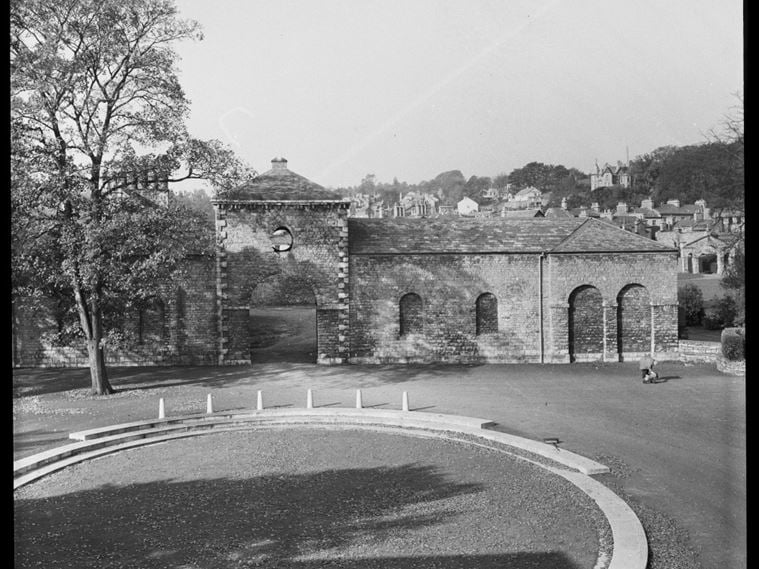
Westmorland
Historic County